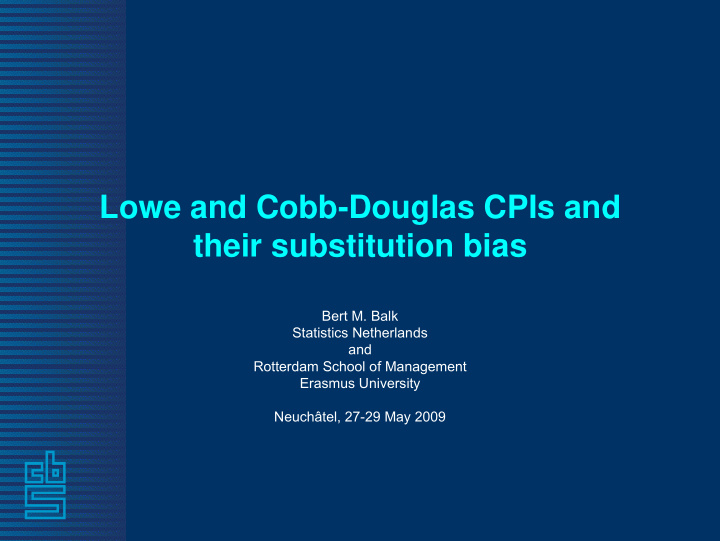



Lowe and Cobb-Douglas CPIs and their substitution bias Bert M. Balk Statistics Netherlands and Rotterdam School of Management Erasmus University Neuchâtel, 27-29 May 2009
Lowe A Lowe price index is defined as P Lo (p t ,p 0 ;x b ) ≡ p t ·x b / p 0 ·x b where p τ ( τ = 0,t) is a vector of prices and x b is a vector of quantities. Typically b ≤ 0 < t.
Cobb-Douglas A Cobb-Douglas price index is defined as 0 ) snb P CD (p t ,p 0 ;s b ) ≡ Π n (p n t /p n where p τ ( τ = 0,t) is a vector of prices and s b is a vector of value shares p n b x n b / p b ·x b . Typically b ≤ 0 < t.
Lowe and CD compared Ex. (24) shows that ln P Lo (p 1 ,p 0 ;x b ) – ln P CD (p 1 ,p 0 ;s b ) can be written as covariance between price- update factors over [b,1] and relative price changes over [0,1]. This is likely to be non- negative, especially when [b,0] is short relative to [0,1].
Benchmark Cost-of-Living index The target Konüs COLI is defined as P K (p 1 ,p 0 ;x b ) ≡ C(p 1 ,U(x b )) / C(p 0 ,U(x b )) where U(.) is the consumer’s utility function and C(.) the dual cost function. It is assumed that in period b the consumer acts cost-minimizing: C(p b ,U(x b )) = p b ·x b .
Second order approximations (1) Taylor series around p b : C(p 1 ,U(x b )) = p 1 ·x b + e 1 C(p 0 ,U(x b )) = p 0 ·x b + e 0 where e t (t = 0,1) are second-order terms which are non-positive.
Bias of Lowe index The relative substitution bias [P Lo (p 1 ,p 0 ;x b ) - P K (p 1 ,p 0 ;x b )] / P K (p 1 ,p 0 ;x b ) is given by ex. (29) and likely to be positive.
Second order approximations (2) An other Taylor series around p b : ln C(p t ,U(x b )) = ln C(p b ,U(x b )) + b ln (p n ∑ n s n t /p n b ) + ε t where ε t (t = 0,1) are second-order terms which are not necessarily non-positive.
Bias of CD index The relative substitution bias ln P CD (p 1 ,p 0 ;s b ) – ln P K (p 1 ,p 0 ;x b ) = ε 0 – ε 1 is given by ex. (34). A priori not much can be said about the sign of this bias.
Comparison See section 6: On balance it is likely that the relative substitution bias of the CD is less than that of the Lowe index. The empirical evidence of section 7 is inconclusive.
Recommend
More recommend